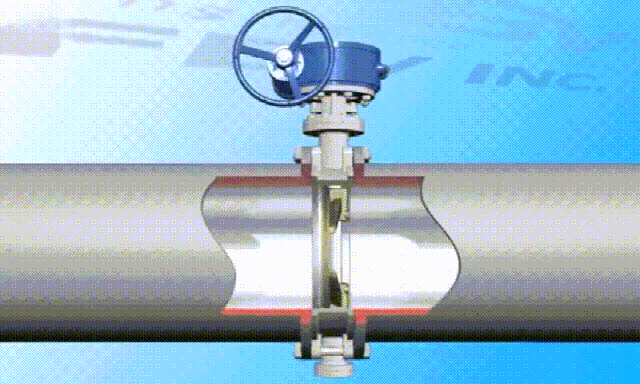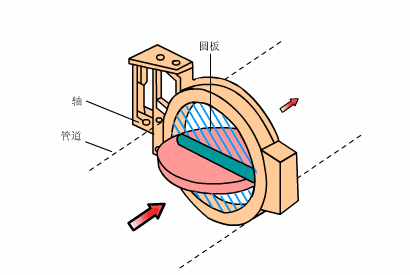Understanding Butterfly Valves
Butterfly valve, also known as flap valve, is a type of regulating valve with a simple structure that can be used for on/off control of low-pressure pipeline media. Butterfly valve refers to a valve whose closing element (valve disc or butterfly plate) is a disc that rotates around the valve axis to achieve opening and closing. It can be used to control the flow of various types of fluids such as air, water, steam, various corrosive media, mud, oil, liquid metals, and radioactive media. It mainly plays a role in cutting off and throttling on pipelines. The butterfly valve opening and closing component is a disc-shaped butterfly plate that rotates around its own axis inside the valve body to achieve the purpose of opening, closing, or adjusting.
1、 Working principle
Butterfly valve is a type of valve that uses a disc type opening and closing element to rotate back and forth about 90 degrees to open, close, or regulate the flow rate of the medium. Butterfly valves not only have a simple structure, small size, light weight, low material consumption, small installation size, low driving torque, easy operation, and fast speed, but also have good flow regulation function and closing sealing characteristics. They are one of the fastest developing valve varieties in the past decade.
2、 Butterfly valve structure
Butterfly valves are mainly composed of valve body, valve stem, butterfly plate, and sealing ring. The valve body is cylindrical in shape, with a short axial length and a built-in butterfly plate.
3、 Advantages
1. Good fluid control performance: When the butterfly valve is in the fully open position, the thickness of the butterfly plate is the only resistance for the medium to flow through the valve body. Therefore, the pressure drop generated through this valve is very small. In addition, the butterfly valve has a small structural length and overall height, and the opening and closing speed is fast, so it has good flow control characteristics.
2. The application of large diameter adjustment is widely used in the field of large diameter adjustment. When the butterfly valve is opened between approximately 15 °~70 °, sensitive flow control can be achieved. Therefore, the application of butterfly valves is very common in the field of large diameter adjustment.
3. The butterfly valve has a lightweight structure, compact body, and relatively low cost. It uses a thin metal disc as the flow control mechanism, and the butterfly plate is small, occupying very little space, but the strength is sufficient to regulate the flow of fluid. And butterfly valves have a compact body, making them suitable for narrow pipeline systems. Large diameter pipelines require the use of larger volume valves, which increases the cost of manufacturing materials. Butterfly valves, due to the use of fewer manufacturing materials, will be cheaper than other valves of the same size, such as ball valves.
4. Sealed fast and efficient butterfly valves provide quick sealing during start-up, making them an ideal choice for high-precision flow applications.
5. Although the valve disc always exists in the fluid, the pressure drop of the butterfly valve is very low. Low pressure drop is crucial for the pumping and energy requirements of management systems, and the design of butterfly valves allows fluids to quickly recover energy after leaving the valve.
6. The maintenance requirements for butterfly valves are relatively low. The internal components of butterfly valves are relatively few, and compared to other valves, butterfly valves do not have “pockets” that can capture liquids or impurities. Therefore, they require less maintenance and intervention, and the installation of butterfly valves is relatively simple, only requiring clamping between adjacent pipeline flanges without complex installation processes such as welding.
7. Due to its compact structure and light weight, butterfly valves require relatively low torque for operation. Thin metal butterfly plates use a small amount of force to overcome the frictional resistance of fluids.
8. It is easier to achieve automation because small actuators can provide sufficient torque for their operation, which translates into lower operating costs – small actuators consume less power and have lower costs to add to valves.
4、 Disadvantages
1. Butterfly valves are not suitable for high-pressure throttling. Butterfly valves can only be used for throttling in low-pressure applications, with an opening limit between 30 degrees and 80 degrees.
2. Butterfly valves are susceptible to cavitation and flow blockage when in the open position. The valve does not provide a complete port, and the presence of a disc in the fluid flow path exacerbates the accumulation of impurities around the valve, increasing the likelihood of cavitation.
3. The corrosion resistance of butterfly valves is relatively low compared to gate valves and ball valves. When the fluid flows through the butterfly valve, it will wash them away. Over time, the disc will deteriorate and can no longer provide a seal. If dealing with viscous fluid services, the corrosion rate will be higher
4. When the valve disc of the butterfly valve is in the fully open position, it will hinder the cleaning of the system and prevent the pipeline containing the butterfly valve from being cleaned.
5、 Installation of butterfly valve
1. During installation, the valve disc should be stopped in the closed position.
2. The opening position should be determined according to the rotation angle of the butterfly plate.
3. Butterfly valves with bypass valves should be opened before opening.
4. The installation should be carried out according to the manufacturer’s installation instructions. For heavy butterfly valves, a solid foundation should be set up.
(Key points for construction and installation)
1. The installation position, height, and import/export direction must meet the design requirements, and the connection should be firm and tight.
2. All types of manual valves installed on insulated pipelines must not have handles facing downwards.
3. Before installing the valve, a visual inspection must be conducted, and the valve nameplate should comply with the current national standard “General Valve Marking” GB 12220. For valves with a working pressure greater than 1.0 MPa and a shut-off function on the main pipeline, strength and tightness tests should be conducted before installation, and they can only be used after passing the tests. During the strength test, the test pressure shall be 1.5 times the nominal pressure, and the duration shall not be less than 5 minutes. The valve shell and packing shall be qualified if there is no leakage. During the tightness test, the test pressure is 1.1 times the nominal pressure; The test pressure should meet the requirements of GB 50243 standard for the duration of the test, and it is considered qualified if there is no leakage on the sealing surface of the valve disc.
Post time: Apr-09-2025


